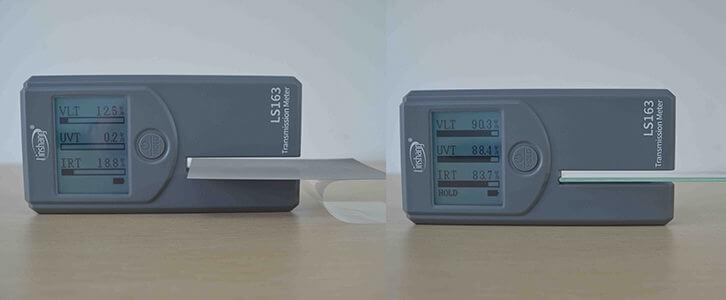How to Check Tinted Automotive Window transmittance using Tint Meter?
1. Why do we check window tint?
When light shines on the glass, there are three cases of reflection, absorption and transmission.The performance of visible light transmitted through the glass is called transmission performance,which is expressed by light transmittance,also called visible light transmittance.The transmittance of automotive glass is generally measured using a light transmittance meter, while for testing window films we can use a tint meter.
At present,the "Safety Technical Conditions for Motor Vehicle Operation" stipulates that the visible light transmittance of the front windshield and the wind window for the driver's viewport should be 70% or more. Many customers will put their own private cars with UV-blocking window film to resist radiation. But for safety reasons,it is recommended to use a professional tint meter to select products with high visible light transmittance for safety. So the driver's visual distance would be safe.
2. How to check tinted automotive window transmittance ?
However, before attaching the window film to the automobile glass, we can only measure the window film transmittance and the automobile glass transmittance respectively by the light transmittance meter.How to estimate the light transmittance of the stick-film glass?
Below we will use the window film and a piece of glass for the demonstration.Since there is no need to measure the light transmittance of the front windshield of the car,we will use the tint meter (window film meter) to replace the light transmittance meter.This instrument can also test the transmittance of the window film and glass. As shown in the figure below,the light transmittance of the window film is 12.5% and the light transmittance of the glass is 90.3%. To calculate the light transmittance of tinted window glass, it is necessary to multiply the light transmittance.

Stick-Film Glass Transmittance = Window Film Transmittance × Glass Transmittance
Through this calculation, we can estimate that the transmittance of the glass after sticking the film is about 11.29%.Next,we attach the film to the glass and directly measure the transmittance value of the filmed glass by the LS163 tint meter to check whether the calculation is correct. As shown in the figure below, the measured transmittance of the filmed glass was 11.3%.
Of course,there is air or stain between the window film and the glass,which will cause the transmittance data to be small.In addition,since the window film and the glass are bonded together, the surface that can be reflected by light is reduced, which causes the increase of the stick-film glass transmittance. The actual light transmittance value will be affected by the filming technology and various factors, but the impact will not be too great. In the same way, the above calculation method can still roughly estimate the light transmittance of a film-coated car.
From the calculation principle,it is not difficult to find that the transmittance of the tinted window glass is smaller than the transmittance of the window film. Therefore,when selecting the window film of the front windshield of the automobile,it is necessary to use a professional tint meter to select the window film with high light transmittance. Otherwise it is easy to appear that the car's light transmittance is not up to standard.
- Choosing the Right Window Tinting Film
- Window Tint Meter | Pros and Selection Methods of Architectural Membrane
- Advantages of LS110H and LS110A Split Transmission Meter
- Best Choice:LS182 Solar Film Transmission Meter
- Solar Power Lightens Up with Thin-Film Technology
- What is the Solar Heat Gain Coefficient Ratings (SHGC)
